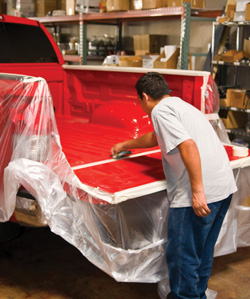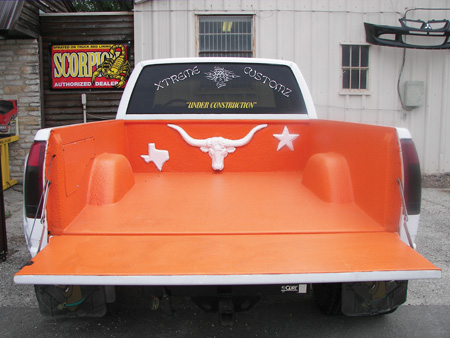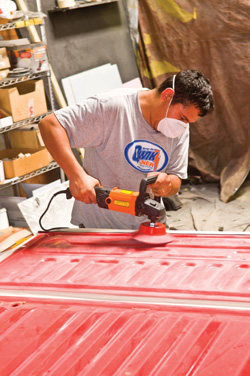

 It seems today that body shops all over the United States are scrambling for a piece of the customer-pay service business. In an effort to circumvent the price games played by insurance companies and for an opportunity to get paid what the market will truly bear, shops are adding mechanical services, detailing and accessories to the list of their offerings to customers.
It seems today that body shops all over the United States are scrambling for a piece of the customer-pay service business. In an effort to circumvent the price games played by insurance companies and for an opportunity to get paid what the market will truly bear, shops are adding mechanical services, detailing and accessories to the list of their offerings to customers.
The burgeoning truck market, while beginning to show some signs of ebbing due to energy costs, is underscored by the fact that the F-150 has been the most popular vehicle sold in the U.S. for nearly every year of the past three decades. This has put millions of pickup trucks on the road.
Every one of these Ford trucks has a life expectancy of nearly 200,000 miles or more. From the STX, XLT, the luxurious Lariat, the even plusher Lariat Limited and the theme-based King Ranch, Eddie Bauer and Harley-Davidson packages, there seems no end to the market for dolling up what was formerly the lowly pickup. Add to these numbers the offerings from other manufacturers (Dodge, Chevrolet, GMC, Toyota and Nissan) and you’re looking at a major contingent of the automotive population.
If you’re wondering about the market for add-on items like sprayed-on bedliners and the general economy, there seems little cause for concern. The Specialty Equipment Manufacturers Association (SEMA) reports that U.S. consumers purchased an unprecedented $38.11 billion of specialty automotive products in 2007, despite a lag in the general U.S. economy. That figure is a 3.78 percent increase from 2006 to 2007, and it represents the 17th consecutive year of growth. While this represents something of a downward trend in terms of the annual increase of consumer spending, the point is that there still is growth in those purchases.
Leading the list of add-on items that consumers with new trucks purchase is sprayed-on bedliners. One item of note with respect to the potential customers for sprayed-on bedliners is that there are quite a few professionals and tradespeople with a clear need to protect their truck beds from the wear and tear of hauling tools, equipment and materials. For them, it’s not as much a cosmetic application but one to retain value and extend the working life of the truck body.
Sprayed-On vs. Drop-In
Drop-in bedliners have been around longer than sprayed-on bedliners, but have been known to be problematic in terms of durability and have hard, slippery surfaces that allow cargo to shift. Sprayed-on bedliners offer permanent, durable protection, can be applied in an array of colors and can add value to pickup trucks. The coatings are all resistant to chemicals, gasoline and abrasion and prevent corrosion in the truck beds. They also offer traction characteristics unavailable in the factory-finished beds and drop-in bedliners.
Steve Billman of Billman’s Auto Body in Grantville, Pa., an independent body shop that took on sprayed-on bedliners as a sideline to its collision repair business after seeing an ad for one particular system in BodyShop Business.
At this point, Billman says 70 percent of his sales volume comes from new car (light truck) dealers, with a particularly strong showing among Dodge truck dealers. He reports that he does more business with Dodge truck dealers than any others and gets anywhere from $400 to $500 for the job, depending on the size of the bed or a customer’s choice of matching color.
The main thing that attracted Billman to the brand of sprayed-on bedliners he uses is the fact that he can inject his basecoat color directly into the bedliner material in order to perfectly match exterior body colors. In terms of marketing his services, his business ran the gamut.
“We did a lot of advertising for it, everything from placemat to radio advertising,” Billman says. “Also, my wife sets up a display at Carlisle truck show every year.”
Opportunities Galore
The number of applications for the sprayed-on bedliner product is limited only by one’s imagination. For example, Billman’s Auto Body contracted with a port-o-potty company to spray the interior of the units, making them much more durable and easier to clean. There have also been individuals who have used the material to coat boat decks and industrial and food processing areas.
And when you consider all the trucks with sprayed-on bedliners on the road, the repair opportunities for existing sprayed-on bedliners open up. As of right now, there’s no labor database for the application and repair of a sprayed-on bedliner that an insurance company can refer to for the purpose of dictating prices. In that sense, it truly is a market-driven service for those with the capability to do it. Bedliners go to that wonderful sublet category of the estimate.
The composition of the material sprayed onto truck beds will vary from the early versions of the polyurethane compounds to the urea systems on the market. There are characteristics of each products’ chemistry that will distinguish one from the other in terms of ease of application and durability of the coatings.
One aspect of sprayed-on bedliners is that of safety precautions for the technicians applying the products. While urethanes have long been known to contain isocyanates, a toxic compound that’s absorbed through the skin, eyes and other mucous membranes of the body, there are some reduced isocyanate products on the market that claim to be safer than the traditional sprayed-on bedliner materials.
Some sprayed-on bedliner products are claiming vast reductions in VOC levels (down to zero VOC content) as well as the isocyanate content, thus making the products more adaptable to applications in more areas of the shop. Lower pressure application means less overspray, less waste of material and less contamination of the worker areas in your shop.
A polyurethane/polyurea coating is the product of a reaction that takes place when an isocyanate component and a resin blend component are combined. The isocyanate can be aromatic or aliphatic in nature. In chemistry classes, we learned that compounds composed of carbon and hydrogen are divided into two classes: aromatic compounds, which contain benzene and other similar compounds, and aliphatic compounds with fat or oil, which do not.
In terms of the chemical compounds used in the sprayed-on truck bedliners, there’s something of a contest between the polyurethane systems and the polyurea systems. One manufacturer that advocates the polyurea system says it isn’t polyurethane but rather a hybrid (80 percent polyurea, 20 percent polyurethane) that needs no heating. They also claim that the polyurethane isn’t as ultraviolet (UV) stable and pits once exposed to long-term
UV rays, an effect that leads to a chalky look on a black bedliner. That school of thought says that polyurea is much more UV stable, flexible and harder at the same time.
In a direct conflict with these claims that polyurethane systems deteriorate with UV exposure are claims of the opposite being true by a manufacturer of a polyurethane-based bedliner system. While it would take a person with a substantial chemical engineering background (certainly not this writer) to distinguish the long-term performances of the two chemical compounds, one needs to investigate on his or her own prior to plopping down the cash required for either system. Speak with existing dealers and customers, and gather anecdotal evidence in order to distinguish what’s true and what’s hype.
Shallow Learning Curve
In terms of training required for the application of the sprayed-on bedliner systems, there seems to be a rather shallow learning curve, especially for body shop technicians. The applicator essentially cleans the surface to be sprayed with a solvent wash, scuffs the OEM paint for adhesion, cleans the sanding dust with another solvent wash and applies the material liberally. Most suppliers provide training via a DVD video or online. Some, however, will train you at their corporate facilities or even make arrangements for you to train in another shop with their system. Others offer onsite training in your facility.
The systems are as varied as can be, with some being low-pressure, high-volume applications using a shop’s compressed air supply, while others use an airless sprayer system with output pressures in excess of 2,500 psi. There are systems that use two-component cartridges similar to those that plastic repair systems use with the static mixing tubes, which tend to offer a more economical entry into the market. At the other end of the spectrum are those systems that use high-pressure delivery systems that move the material through a heated hose, which are more economical in large-scale use.
In any event, the market has opened up with a tremendous choice of sprayed-on bedliner systems for body shop operators with a hankering to take advantage of this opportunity.
Writer Charlie Barone has been working in and around the body shop business for the past 35 years, having owned and managed several collision repair shops. He’s an ASE Master Certified technician and a licensed damage appraiser, and has been writing technical, management and opinion pieces since 1993. Barone can be reached via e-mail at [email protected].













